《植物化学保护》课程教学资源(英文讲稿)TOXICOLOGY III Risk Assessment(PPT)
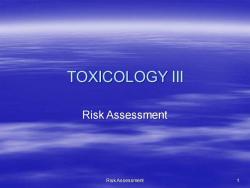
TOXICOLOGY III Risk Assessment RiskAssessment 1
Risk Assessment 1 TOXICOLOGY III Risk Assessment
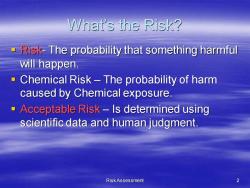
What's the Risk? Risk-The probability that something harmful will happen. Chemical Risk-The probability of harm caused by Chemical exposure. Acceptable Risk-Is determined using scientific data and human judgment. Risk Assessment 2
Risk Assessment 2 What’s the Risk? ▪ Risk- The probability that something harmful will happen. ▪ Chemical Risk – The probability of harm caused by Chemical exposure. ▪ Acceptable Risk – Is determined using scientific data and human judgment
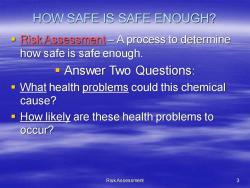
HOW SAFE IS SAFE ENOUGH? Risk Assessment-A process to determine how safe is safe enough. -Answer Two Questions: What health problems could this chemical cause? How likely are these health problems to occur? RiskAssessment 3
Risk Assessment 3 HOW SAFE IS SAFE ENOUGH? ▪ Risk Assessment – A process to determine how safe is safe enough. ▪ Answer Two Questions: ▪ What health problems could this chemical cause? ▪ How likely are these health problems to occur?
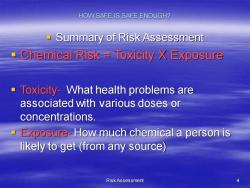
HOW SAFE IS SAFE ENOUGH? Summary of Risk Assessment Chemical Risk Toxicity X Exposure Toxicity-What health problems are associated with various doses or concentrations. Exoosure-How much chemical a person is likely to get(from any source) RiskAssessment
Risk Assessment 4 HOW SAFE IS SAFE ENOUGH? ▪ Summary of Risk Assessment ▪ Chemical Risk = Toxicity X Exposure ▪ Toxicity- What health problems are associated with various doses or concentrations. ▪ Exposure- How much chemical a person is likely to get (from any source)

HOW SAFE IS SAFE ENOUGH? High chemical risk requires both high toxicity AND exposure. May household chemicals are highly toxic but proper RISK MANAGEMENT can reduce risk. RiskAssessment 5
Risk Assessment 5 HOW SAFE IS SAFE ENOUGH? ▪ High chemical risk requires both high toxicity AND exposure. ▪ May household chemicals are highly toxic but proper RISK MANAGEMENT can reduce risk
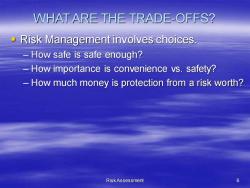
WHATARE THE TRADE-OFFS? Risk Management involves choices. How safe is safe enough? -How importance is convenience vs.safety? How much money is protection from a risk worth? RiskAssessment 6
Risk Assessment 6 WHAT ARE THE TRADE-OFFS? ▪ Risk Management involves choices. – How safe is safe enough? – How importance is convenience vs. safety? – How much money is protection from a risk worth?
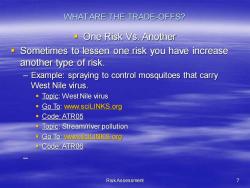
WHATARE THE TRADE-OFFS? ·One Risk Vs.Another Sometimes to lessen one risk you have increase another type of risk. -Example:spraying to control mosquitoes that carry West Nile virus. Topic:West Nile virus Go To:www.sciLINKS.org ·Code:ATR05 Topic:Stream/river pollution Go To:www.sciLINKS.org ·Code:ATR06 RiskAssessment 7
Risk Assessment 7 WHAT ARE THE TRADE-OFFS? ▪ One Risk Vs. Another ▪ Sometimes to lessen one risk you have increase another type of risk. – Example: spraying to control mosquitoes that carry West Nile virus. ▪ Topic: West Nile virus ▪ Go To: www.sciLINKS.org ▪ Code: ATR05 ▪ Topic: Stream/river pollution ▪ Go To: www.sciLINKS.org ▪ Code: ATR06 –
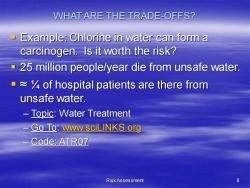
WHAT ARE THE TRADE-OFFS? Example:Chlorine in water can form a carcinogen.Is it worth the risk? 25 million people/year die from unsafe water. %of hospital patients are there from unsafe water. Topic:Water Treatment -Go To:www.sciLINKS.org Code:ATR07 RiskAssessment 8
Risk Assessment 8 WHAT ARE THE TRADE-OFFS? ▪ Example: Chlorine in water can form a carcinogen. Is it worth the risk? ▪ 25 million people/year die from unsafe water. ▪ ≈ ¼ of hospital patients are there from unsafe water. – Topic: Water Treatment – Go To: www.sciLINKS.org – Code: ATR07
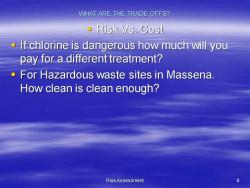
WHAT ARE THE TRADE-OFFS? Risk Vs.Cost -If chlorine is dangerous how much will you pay for a different treatment? For Hazardous waste sites in Massena. How clean is clean enough? RiskAssessment
Risk Assessment 9 WHAT ARE THE TRADE-OFFS? ▪ Risk Vs. Cost ▪ If chlorine is dangerous how much will you pay for a different treatment? ▪ For Hazardous waste sites in Massena. How clean is clean enough?
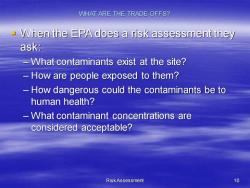
WHAT ARE THE TRADE-OFFS? When the EPA does a risk assessment they ask: -What contaminants exist at the site? How are people exposed to them? How dangerous could the contaminants be to human health? -What contaminant concentrations are considered acceptable? RiskAssessment 10
Risk Assessment 10 WHAT ARE THE TRADE-OFFS? ▪ When the EPA does a risk assessment they ask: – What contaminants exist at the site? – How are people exposed to them? – How dangerous could the contaminants be to human health? – What contaminant concentrations are considered acceptable?
按次数下载不扣除下载券;
注册用户24小时内重复下载只扣除一次;
顺序:VIP每日次数-->可用次数-->下载券;
- 《植物化学保护》课程教学资源(英文讲稿)Toxic Effects of Pesticides.pdf
- 《植物化学保护》课程教学资源(英文讲稿)The Influence of Secondary Standards on Pesticide Use.pdf
- 《植物化学保护》课程教学资源(英文讲稿)The Impacts of Adoption of Genetically Engineered Crops on Yields, Pesticide Use and Economic Returns in the USA.pdf
- 《植物化学保护》课程教学资源(英文讲稿)Storage and Disposal.pdf
- 《植物化学保护》课程教学资源(英文讲稿)Plastic Pesticide Container Recycling.pdf
- 《植物化学保护》课程教学资源(英文讲稿)Pesticides.pdf
- 《植物化学保护》课程教学资源(英文讲稿)Pesticides Analysis with the new Agilent 6220 6460 and 6530.pdf
- 《植物化学保护》课程教学资源(英文讲稿)Pesticide Waste Challenges.pdf
- 《植物化学保护》课程教学资源(英文讲稿)Pesticide Toxicology and Risk Assessment.pdf
- 《植物化学保护》课程教学资源(英文讲稿)Pesticide Toxicity.pdf
- 《植物化学保护》课程教学资源(英文讲稿)Pesticide Safety and Toxicity(PPT).ppt
- 《植物化学保护》课程教学资源(英文讲稿)Pesticide Registration for Minor Crops and Crop Grouping Effort in Japan.pdf
- 《植物化学保护》课程教学资源(英文讲稿)Pesticide Laws and Regulations.pdf
- 《植物化学保护》课程教学资源(英文讲稿)Pesticide Health Hazards - Exposure and Personal Protective Equipment.pdf
- 《植物化学保护》课程教学资源(英文讲稿)Pesticide Hazards and First Aid(PPT).ppt
- 《植物化学保护》课程教学资源(英文讲稿)Pesticide Formulas and Properties.pdf
- 《植物化学保护》课程教学资源(英文讲稿)Pesticide Contamination in Rural Areas.pdf
- 《植物化学保护》课程教学资源(英文讲稿)Pesticide Toxicology(PPT).ppt
- 《植物化学保护》课程教学资源(英文讲稿)Oklahoma Unwanted Pesticide Disposal Program.pdf
- 《植物化学保护》课程教学资源(英文讲稿)No Spray Buffers Lawsuits & Toxicology.pdf
- 《植物化学保护》课程教学资源(英文讲稿)Work and Residential Characteristics Related to Pesticide Exposure among Latino Farmworkers.pdf
- 华南农业大学:《普通昆虫学》课程教学大纲(负责人:王敏).pdf
- 华南农业大学:《普通昆虫学》课程授课教案(讲义,共五篇).docx
- 华南农业大学:《普通昆虫学》课程教学资源(实验指导)实验一 昆虫体躯的基本结构和昆虫的头部.pdf
- 华南农业大学:《普通昆虫学》课程教学资源(实验指导)实验二 昆虫的胸部和腹部.pdf
- 华南农业大学:《普通昆虫学》课程教学资源(实验指导)实验三 昆虫的卵、胚胎发育和胚后发育.pdf
- 华南农业大学:《普通昆虫学》课程教学资源(实验指导)实验四 昆虫纲分目(Ⅰ).pdf
- 华南农业大学:《普通昆虫学》课程教学资源(实验指导)实验五 昆虫纲分目(Ⅱ).pdf
- 华南农业大学:《普通昆虫学》课程教学资源(实验指导)实验六 等翅目、直翅目和缨翅目分科.pdf
- 华南农业大学:《普通昆虫学》课程教学资源(实验指导)实验七 半翅目和脉翅目分科.pdf
- 华南农业大学:《普通昆虫学》课程教学资源(实验指导)实验八 同翅目分科.pdf
- 华南农业大学:《普通昆虫学》课程教学资源(实验指导)实验九 鞘翅目分科.pdf
- 华南农业大学:《普通昆虫学》课程教学资源(实验指导)实验十 鳞翅目分科(成虫).pdf
- 华南农业大学:《普通昆虫学》课程教学资源(实验指导)实验十一 鳞翅目分科(幼虫).pdf
- 华南农业大学:《普通昆虫学》课程教学资源(实验指导)实验十二 双翅目科.pdf
- 华南农业大学:《普通昆虫学》课程教学资源(实验指导)实验十三 膜翅目分科.pdf
- 华南农业大学:《普通昆虫学》课程教学资源(实验指导)实验十四 昆虫内部器官的位置、体壁、消化系统.pdf
- 华南农业大学:《普通昆虫学》课程教学资源(实验指导)实验十五 昆虫的呼吸系统、循环系统、神经系统、内分泌系统和生殖系统.pdf
- 华南农业大学:《普通昆虫学》课程教学资源(实验指导)实习一 昆虫标本的采集、制作与保存.pdf
- 华南农业大学:《普通昆虫学》课程教学资源(实验指导)实习二 微小昆虫玻片标本的制作.pdf
